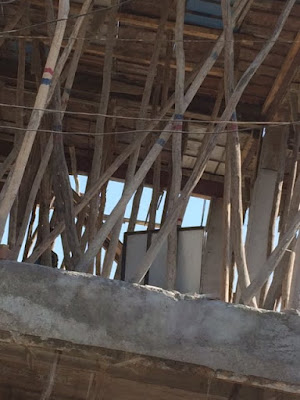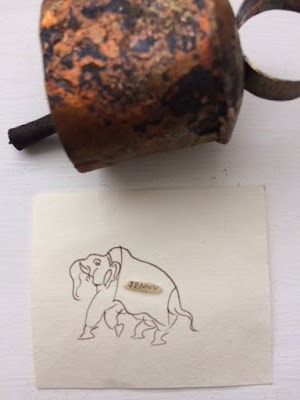 |
| Making pots and weaving rugs in the desert. |
Sunday 15 April 2018
Monday 9 April 2018
The best things I bought
 |
| Beautiful hand embroidered trim - a metre of each |
If ever I am lucky enough to go back to India I can imagine heading straight for the little shop where I bought these fantastic sari edgings.
Before I opened my Handmade Happiness shop in Petersfield I dreamed of owning a habadashery shop selling the most beautiful ribbons and buttons. Imagine selling something as incredible as these!
The lower trim is really old and the pink one seems quite new.
If this is the first thing you read please scroll down to the first post titled 'Have yellow hat can travel' and read upwards. And if you find I've made a spelling mistake or you have anything to tell me, email jennystacy6@gmail.com
I'd love to hear from you.
And if you want to read about my shop click onto Handmade Happiness top right.
Thank you for reading.
What I bought in India
Saturday 7 April 2018
Inside the City Palace, Udaipur
 |
| Detail of painting of crocodile pool inside the palace |
 |
| Coloured glass changing the light inside the room |
 |
| Peeling paint has a strange beauty especially in these blues |
 |
| Curved mirrored pieces in this mosaic |
 |
| A glass room |
 |
| This is huge, about the size of two average rooms |
Friday 6 April 2018
Day Fourteen - Udaipur - the City Palace and a Tibetan market
 |
| Looking from the winter palace across to the summer palace |
 |
| A decorated archway |
 |
| Our city palace guide with film star good looks! |
 |
| So much detailled decoration to gaze at |
 |
| A lattice window |
 |
| Fantastic painting - with just one hair from a squirrel's tail |
A day when I took 60 pictures.
In the morning we visited the huge City Palace on the shores of Lake Pichola. The Lake Palace was where the ruler and his family decamped to for the summer months and there were boat rides out there but I was too entranced by the decorative walls, windows and ceilings of the larger palace on the shore.
There were rooms of coloured glass and intricately painted ceilings. Artists' finely painted scenes of life as it was then. I'll do another post just of pictures to show you these things.
We were shown round by the impossibly handsome man pictured. Maybe he acted as guide round the City Palace when not starring in Bollywood movies !?
Each room inside the palace was a colourful thing of wonder, and outside there were guards on horseback dressed in red and orange and holding flags. There was also an enormous 'portable cage for trapping and keeping tigers.'
This place is a feast for the imagination. There was a picture of an indoor pool containing crocodiles...and a room containing just cages for carrier pigeons.
All too soon we had to move on to the Jagdish white marble temple nearby dedicated to Lord Vishnu, preserver of the universe. Here for the first time we heard loud chanting and singing...
After lunch at the hotel we drove back into the town centre. It was the last day and still I hadn't got any cotton fabrics. We were taken to a plush building and were asked to sit down to listen to a talk by the textile house owner. I had a creeping sense of deja vu (see Day Eleven) and quietly myself and several others left the building.
We had spotted a Tibetan market from the coach and here, at last I found the simple printed cottons I had been hoping for.
I bought several of the largest size of long nightdresses in assorted prints and colours for between £2 and £4 each knowing that there here was lots of fabric that could be re-used.
Feeling very happy we walked down the narrow shopping streets and found handmade banana paper and, best of all, some stunning beaded ribbons, that I am now wishing I'd bought more of. (pictures soon)
I bought several of the largest size of long nightdresses in assorted prints and colours for between £2 and £4 each knowing that there here was lots of fabric that could be re-used.
Feeling very happy we walked down the narrow shopping streets and found handmade banana paper and, best of all, some stunning beaded ribbons, that I am now wishing I'd bought more of. (pictures soon)
Thursday 5 April 2018
Day Thirteen - Jodhpur to Udaipur
 |
| The Royal Enfield Bullet worshipped at its own temple |
 |
| Scaffolding of wood, not metal |
 |
| I love these table runners where we stopped for lunch |
 |
| Why don't we have signs like this in England?!! |
Tuesday 3 April 2018
Day Twelve - Bishnoi
 |
| The potter and his wheel |
 |
| A Bishnoi house - although we didn't think it was actually lived in nowadays |
 |
| Inside a Bishnoi home |
 |
| A 'fridge' to keep food safe from animals |
 |
| Looking down on the carpet weavers loom |
 |
| A finished dhurrie or large rug |
By jeep to remote Bishnoi village where the nature-worshipping Bishnoi people live. Apparently some soldiers once tried to cut down some trees here for firewood but the villagers revered their trees and tried to protect them. The soldiers then killed all the villagers near the trees including women and children. Since then the villagers themselves have been revered. The men wear only white and trees and animals are never harmed.
We watched a potter with his heavy stone wheel throwing pots. He set a heavy stick into a hole in its circumference and physically turned it, setting it spinning until it built up its own momentum. A large piece of clay was stuck onto the wiped clay in the centre and the potter pulled off bowls, their lids, even a money box.
A woman in our group wanted to have a go but she hadn't the strength to get the wheel spinning with the stick.
Then to a typical Bishnoi house with cattle tethered nearby and a woman inside the house separating curds from whey.
The jeeps drove us to a Bishnoi carpet weaver who spoke perfect English. He said machines could never achieve what he could because of interlocking. The dhurries he worked on were made of cotton yarn and camel hair. The colours were natural dyes made from ruddle, a mined stone to achieve red; blue from indigo and black from a mixture of aubergine and cloves.
I bought a small rug from this man and it's sitting in my tiny hall right now reminding me of my fascinating trip to Bishnoi.
Saturday 31 March 2018
Day Eleven - Jodhpur - textile city
 |
| The 15th century Mehrangarh Fort |
 |
 |
| At Jaswanth Thada - the memorial to Maharaja Jaswanth Singh II |
 |
Wednesday 28 March 2018
Luxury camping at Manvar
 |
| Our tent |
 |
| Windows, draped walls and twin beds |
 |
| I slept in the left hand bed |
 |
| Running water in the separate bathroom |
Tuesday 27 March 2018
Day 10 - Scary Jeep rides, camels and goats towards Manvar camp
 |
| A metal worker who sold us goat bells. Note how his wife's face remains covered. |
 |
| Driving over sheer precipices! |
 |
| Camels pulling us in carts |
 |
| Standing on top of a sand dune |
 |
| Boy goat herd chopping leafy branches for his goats below |
Driving deeper into the Thar Desert, I noticed that many of the women we saw had covered faces. We were near the Pakistan border so the Muslim influence was strong.
En route to Manvar Camp we stopped off at this blacksmith's home to watch him working with sheets of metal which his strong young grandson hit hard with a mallet to flatten and shape the hot metal. He sold goat bells for 100 rupees each (just over £1) and now I wish I'd bought more than one. Their sound is so evocative of the goat herds that used to pass our house when, as a child, I lived in the Middle East.
Next the jeep rides over the sand dunes to take us to the camels.
The open back jeeps took 8 people. Their drivers were competitive, macho types and I guess they scored points for making their passengers scream the loudest!
They drove innocently along until suddenly we would find ourselves on top of a sand dune with a sheer drop on one side. I inwardly pleaded with the driver not to attempt to drive down it. No use. It was terrifying and we screamed, clinging to one another for dear life. I feared the jeep would turn over but after many of these sheer drops I grew to trust our driver.
Eventually we were dropped off near a group of camels and their owners. The more brave among us rode on top of the camels towards the tents where we were to spend the night, and the rest (me included) were pulled in camel carts (see above.)
Camels, 'ships of the desert' can apparently survive without water for as long as 14 days, storing what they need in their hump. They have a reputation for being bad tempered and for spitting. But these camels were docile and, although the head of the camel behind us loomed just inches above my head, it never spat or even dribbled. That camel ride was one of the nicest experiences of the holiday and the camels took us to our beautiful tents. (pictures soon) Definitely glamping not camping!
Monday 26 March 2018
Day Nine - Desert breakdown
 |
| Driving into the desert. I think these are acacia trees |
 |
| A tyre blew miles from anywhere but the driver and trusty co-driver were able to fix it |
 |
| The impressive foyer of the Gorbandh Palace Hotel |
 |
| Jaisalmer Fort |
 |
| Colour |
Subscribe to:
Posts (Atom)









